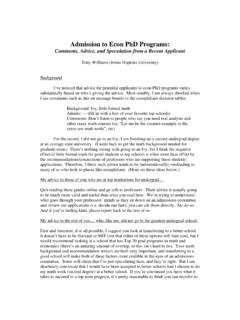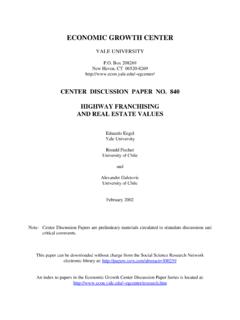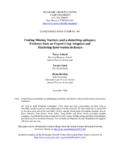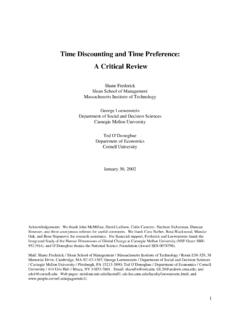Transcription of ECON 600 Lecture 5: Market Structure - Monopoly
1 ECON 600. Lecture 5: Market Structure - Monopoly I. The Definition of Monopoly Monopoly : a firm that is the only seller of a good or service with no close substitutes. This definition is abstract, just as the definition of perfect competition is abstract. And just as it's hard to find a Market that really seems perfectly competitive in all respects, it's hard to find a firm that is a total Monopoly . The source of ambiguity is the term close substitutes. How close is close? For example, is Amtrak a Monopoly ? Yes, if you're concerned with long-distance passenger rail service. Not really, if you're concerned with local rail travel (consider SEPTA, New Jersey Transit, etc.), or with long-distance transportation (consider buslines and airlines). Definitely not if you're concerned with transportation broadly speaking (consider all of the above plus cars). What counts as a substitute is ultimately a matter of consumer's preferences, which are generally not in the form of perfect complements or perfect substitutes.
2 Still, there are various situations that seem to qualify for use of this model: local phone companies in most areas, at least until recently, municipal cable monopolies, etc. Why might there be only one firm in a Market ? There can be various reasons, some of which we discussed earlier: high costs of entry, patent protection, government licensing or exclusive grants, etc. Later, we'll talk about another: economies of scale, which can lead to natural Monopoly in some cases. II. The Single-Price Monopolist The analysis here is pretty much identical to our generic theory of the firm. The main difference is in interpretation: here, we interpret the firm's demand curve as the entire Market demand, not just a fraction of it. As a result, we expect a monopolist's demand curve to be steeper than a generic firm's, because consumers lack the ability to substitute the products of other firms. The picture is identical to that of the generic firm, except we use capital Q and capital D.
3 For quantity and demand, respectively, to indicate that we're talking about the entire Market being served by just one firm. Note that, unlike in perfect competition, we draw only a single diagram, rather than side-by-side Market -and-firm. Just as in the generic analysis, we can find whether the firm is making profits or losses by drawing in the ATC curve. And there's nothing contradictory about a Monopoly making losses. If a monopolist is making losses, it means that it doesn't make economic sense to produce the good in question at all, because even under the most favorable conditions to the producer he cannot get revenues sufficient to cover all opportunity costs of production. In general, economists are hostile to monopolies, and here is why: It is apparent that the firm could produce more units, at a marginal cost lower than what the remaining customers would be willing to pay. As a result, there is a dead-weight loss (DWL) from mutually beneficial trades not made.
4 MC. DWL. Pm Pc D. Qm Qc MR. Recall that under perfect competition, firms priced at marginal cost (P = MC). If the Monopoly did that, its price would be Pc and its quantity Qc, as shown in the diagram. (The c is for competitive.) So we say that the Monopoly causes losses in wealth relative to the perfectly competitive benchmark. (However, we will later talk about reasons why this may be somewhat misleading.). But there's something fishy here. If the units from Qm to Qc cost less to produce than consumers will pay for them, why doesn't the monopolist choose to produce them? The answer depends crucially on the single-price assumption, which says that the monopolist must charge a single price for all units. This could be because the firm cannot distinguish high-price consumers from low-price consumers. The single- price assumption is responsible for MR being below demand. The firm would like to be able to sell from Qm to Qc if it could charge Pc for those units.
5 But doing that would require selling the units from zero to Qm at Pc instead of Pm, and it's not worth it to do that. III. Welfare Analysis of Monopoly (First Pass). Welfare analysis means analyzing who gains and who loses from a policy or situation. In this case, it is clear that producers gain from monopolization or increased concentration of an industry assuming, of course, that they are among those who remain in business. Under perfect competition, they would make lower profit (and zero profit in the long run). Notice that the competitive price and quantity are not the profit-maximizing profit for the single firm, so it must be true that Monopoly is better for the producer. Consumers, on the other hand, end up worse off. Why? Because the quantity they get is smaller, and they pay a higher price for the units they do buy. This higher price is, naturally, the reason monopolization is good for the producer. The difference between the Monopoly and competitive prices, multiplied by the Monopoly quantity, is called the transfer from monopolization.
6 Note that in this context, the transfer is a shift in wealth relative to what consumers would have had in a perfectly competitive Market . If we imagine a previously competitive Market being suddenly monopolized, the transfer is the amount of wealth taken from consumers and given to the monopolist by the act of monopolization. It is because the transfer outweighs the monopolist's portion of DWL (the part below the competitive price) that the monopolist chooses to produce at Qm instead of Qc. From a pure efficiency perspective, the transfer is irrelevant. What makes Monopoly inefficient is the existence of DWL. IV. Welfare Analysis of Monopoly (Second Pass). All of the above seems to imply that a Monopoly necessarily leads to higher price, lower quantity, and dead-weight losses relative to perfect competition. But this may not be true, because a Monopoly may be able to achieve cost savings unavailable to smaller firms.
7 Consolidation to serve larger numbers of consumers can allow the firm to take advantage of greater economies of scale, moving to a lower ATC and corresponding MC. For example, consider this diagram. $. SRATC1. SRATC2. LRATC. q1 q2 q In this situation, one large firm operating at SRATC2 could produce at a much lower cost than three firms operating at SRATC1. The corresponding MC would tend to push down price and increase quantity, hence passing some of the benefits on to the consumers. Thus, the picture we drew earlier of CS, PS, etc., might not be valid, because the MC. under Monopoly is not the same as under perfect competition. So we have two effects of greater concentration (fewer firms with greater Market share each) in an industry. First, competition is reduced, which tends to drive prices up. Second, cost savings may be realized from economies of scale, which tends to drive prices down. So which effect dominates?
8 This is an empirical question. It is highly relevant to many policy questions, such as whether the FTC will allow a merger to take place. Obviously, much of the analysis here is useful not just for Monopoly , but for any industry with imperfect competition. V. Price Discrimination (the Multi-Price Monopoly ). As noted earlier, the monopolist would like to sell to consumers who won't buy at the Monopoly price, if it could do so without lowering price for everyone else. So if the monopolist can distinguish between different groups of consumers, it may wish to charge differential prices. This requires, of course, being able to prevent resale of the product by low-price buyers to high-price buyers. Incidentally, this is not a phenomenon limited to monopolists; it can be done by any firm that faces a downward-sloping demand curve and has the ability to distinguish between customer groups. Price discrimination is defined as charging different prices to different consumers on the basis of non-cost-related characteristics of the consumers.
9 Note that it must be the same product or similar product with the same cost Structure . For instance, charging a different price for first-class seats on an airplane is not an instance of (pure) price discrimination;. nor is charging different prices for gasoline with different octane levels. In general, the most important factor for price discrimination is distinguishing different elasticities, to isolate people who are more or less sensitive to price. People with more elastic demand will tend to be charged a lower price; people with more inelastic demand will tend to be charged a higher price. Examples of price discrimination: Movie prices (for students and seniors). Airline prices (for business and personal). Grocery coupons ( smart versus casual shoppers). 10-10-321 and other long-distance services (price sensitive v. not price sensitive). In order for a firm to be able to price discriminate, it needs to meet three conditions.
10 First, it has to have some degree of Market power; that is, it must not be in a perfectly competitive industry. This is equivalent to the condition that the firm must face a downward-sloping demand curve. Second, the firm must be able to identify distinct customer groups with different elasticities. Third, the firm must be able to prevent (or limit) resale from low-price customer groups to high-price customer groups. What are the effects of price discrimination? It tends to transfer wealth from consumers to producers. It does this because some inelastic consumers, who would have paid a lower price under a single-price Monopoly , end up paying more under price discrimination. This is equivalent to their experiencing a larger transfer of wealth (see discussion on transfers above). It tends to decrease dead-weight loss for both consumers and producers. This is because the firm can charge a lower price to more elastic consumers, for units that it would otherwise not have sold.

















